ArtHOPPER reviews the new shows
10/04/14
Fruit cake still costs 98 cents
April 8, 2014 by Jimmy Kuehnle
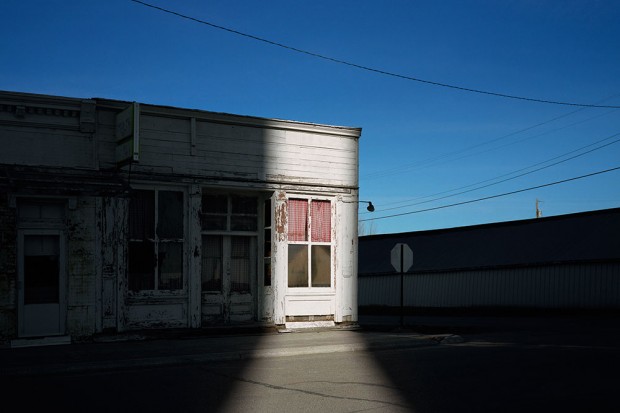
Ray of Light. Christian Patterson.2007. Archival pigment print 40 x 60 inches. Collection of Fred and Laura Ruth Bidwell. Photo courtesy of artist.
Science wins. Check and mate.
Now on to tasty fruit cake.
It still costs 98 cents, for a whole cake or just a piece? It must come with pink icing and a red cherry. Tires still have gleaming wide white walls. A murder’s hair comes pre-sculpted like James Dean’s and hood ornaments project out longer than a foot.
Looking at the images from Redheaded Peckerwood by Christian Patterson, we fall into another time, a surreal time. Except for some archival images and artifacts all are contemporary to within the last nine years, though the presence of a different time inhabits the images. Even the unrelated house fire seems like a still from a movie featuring John Wayne fighting oil well fires. Questions arise. Who wore or wears the white fur coat? Who spilled anti freeze in the snowy tire tracks. Did the murder or murderers see this yellow-flowered wallpaper? Whose soda bottle is that? What happens after the shot is fired? Violence, pain, tragedy, loss of innocence happens.
Christian said that his interest in photography grew after moving to New York in the late 1990’s. Later he traveled to Memphis and for three years worked as William Eggleston’s full time assistant and archivist. He said that as a child of the 1970’s he felt a familiarity and nostalgia with Eggleston’s work and in Memphis he incubated and matured as an artist. He became more self-aware and self-critical and filled with a desire to make work truly his own.
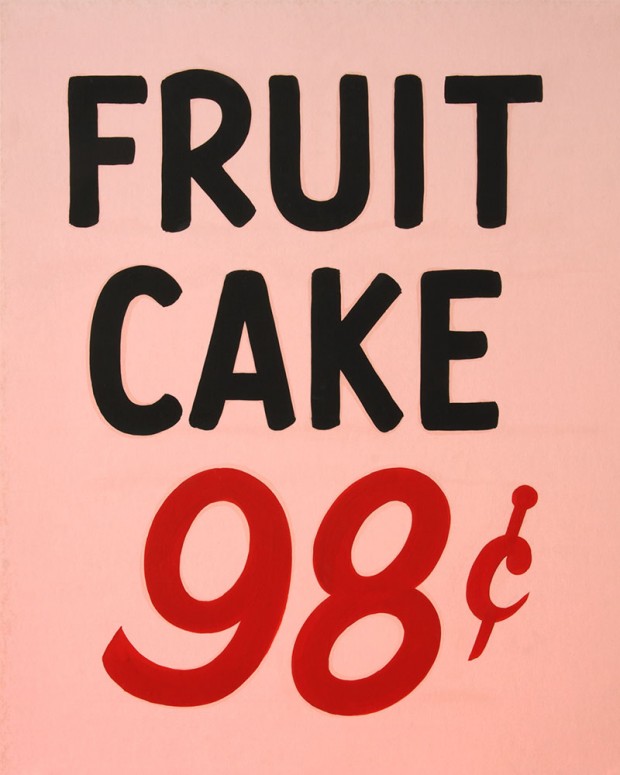
Fruit Cake. Christian Patterson. 2011. Oil on paper board. 20 x 16 inches. Collection of the artist. Photo courtesy of artist.
Later, he saw the film, Badlands, based on a true story of Charles Starkweather, a 19-year-old from Lincoln, Nebraska, with his 14-year-old girlfriend, Caril-Ann Fugate, murdering 11 people during America’s simultaneous experience of the emergence of the teenager, the cold war and the space race. The real story, so much more horrible than the romantic depiction in the movie, provided the artist a road map to travel and take photographs along the way. The exhibition at the Transformer Station traces the artist’s five-year annual trek to the site of Nebraska’s most infamous murder story.
In the winter of January 2005 with average temperatures around 22 degrees, he first traced the path 500 miles west and then 500 miles east. He repeated this pilgrimage five times over five years, at the same time of year the murders took place, working for seven to ten days each visit. He worked as a detective in reverse as well as a photographer and looked for traces of the past still in the present.
Research included visits to the archives of newspapers that originally covered the story, police archives, museums and sites of the crimes. He combed through piles of old documents covered with the patina of time. Does the artist serve multiple roles as curator, detective, photographer, archivist? Inspecting victim’s wallets filled with everything from the mundane to bitter-sweet, brutal crime scene photographs and the real murder weapons chillingly reminded Patterson this was not a movie.
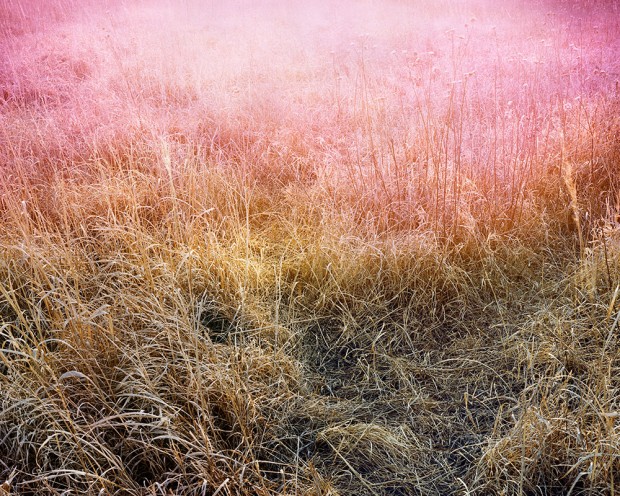
Prairie Grass Leak. Christian Patterson. 2009. Archival pigment print. 40 x 50 inches. Collection of Fred and Laura Ruth Bidwell. Photo courtesy of artist.
Glancing around the room we begin our own journey of discovery. The images of different sites and subject matter begin to give a full picture of a time and place inhabited by real people. Sunlight frames a door to a shop. Pink stripes in slushy snow evoke blood as does a kept photographic accident that allowed light to spill into the large format camera creating a pink haze over a field of tall grass. Did the police chase the suspects through this field? Museum board with shotgun blasts remind us that we too would tear apart from the all too real gun violence. The whole situation is “bad news.”
Similar to how our eyes constantly dart around the real environment, in the gallery we construct a virtual image in our brain from many small slices rather than taking in one big organic megapixel image. Jumping from an old gas station to a soda bottle, to a burnt out neon hotel sign, to fire, to shotgun blasts, a tire, a field of futile flight, a dingy stuffed blue poodle facing the wall, a smiling happy couple, we create our own virtual world in our heads, somehow more complete than an accurate play by play of events.
The contemporariness of the photographs makes them even more full and real. Everything once had a place and meaning in the world but now stripped of location and context the viewer must provide meaning. In his artist talk at the Transformer Station, about the visual presentation of the research and story, he said it is an “attempt to reconstruct, deconstruct, and ultimatly fragment it and ultimately turn it inside out.” He produced accurate handmade copies of documents found in the archives and included them in the middle pages of the book.
The images have a forensic feel. By including photographs with evidence of the artist’s presence, such as a dirty bed slept in after a late night at the bar while on location, the filth seems to coat the artist as he gets too close to horror and can not avoid contamination. Tragedy permeates the story and them more we look, it saturates us. Patterson inserts himself, referencing news art by outlining in gray a bottle of Oregon Trail soda set on a diner counter, the actual bottle found rolling around in the trunk of getaway car, borrowed for a few hours from a museum.
Since only two people know what really happened and one of them is dead, the artist lets go of truth and documentation and tells a compelling visual story. The artist leaves decisions to us. Complexity, evidence and mystery lies waiting for our journey to explore, to dive in.
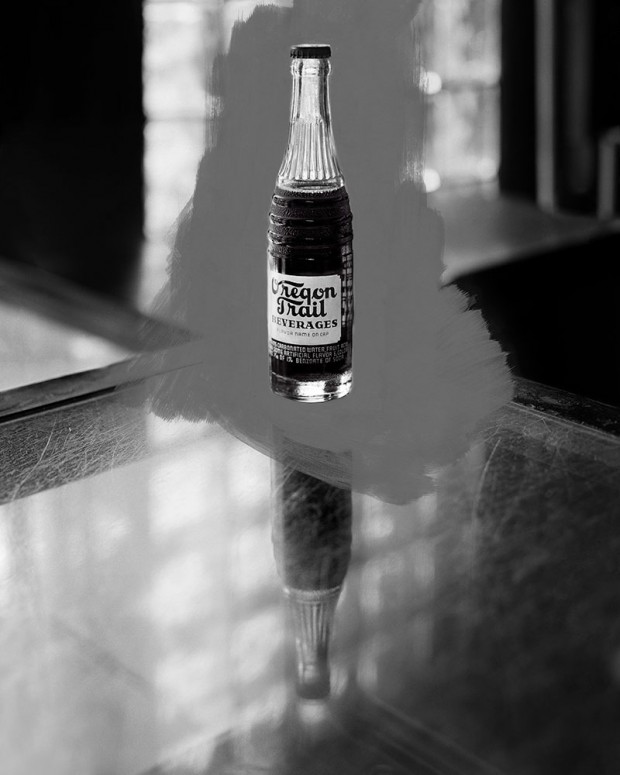
Oregon Trail Bottle. Christian Patterson. 2007. Hand-painted silver gelatin print. 8 x 10 inches. Collection of Fred and Laura Ruth Bidwell. Photo courtesy of artist.
What’s the score? Right, Science up but Art remains in the game, like the Harlem Globetrotters toying with their “stooge” opponent, the Washington Generals.
In the catalog interview with Lisa Kurzner, Jordan Tate discusses the need for “single point objective perception” for communication. He tells the story of Descartes observation of how a stick appears bent in the water. Jordan says that assumes “we actually believed the stick was bent” and that a world where sticks really bend in water would be no different than a world wear they only appear bent “when it is accepted as reality.” We live in such a world. Each time we look at a sunrise we see the bent stick and accept it as reality. The earth’s atmosphere acts as a lens, bending the light of the sun up so the sun appears two minutes before it actually “rises”. Unlike the bent stick, we all believe we directly observe the sun yet we observe something eight minutes in the past and in the case of a sunrise something that will not “really” happen for another two minutes.
Science may trump Art in providing a “single point objective perception” for communication but Art charges up, amplifies, energizes and contextualizes our human experience of those communications of reality.
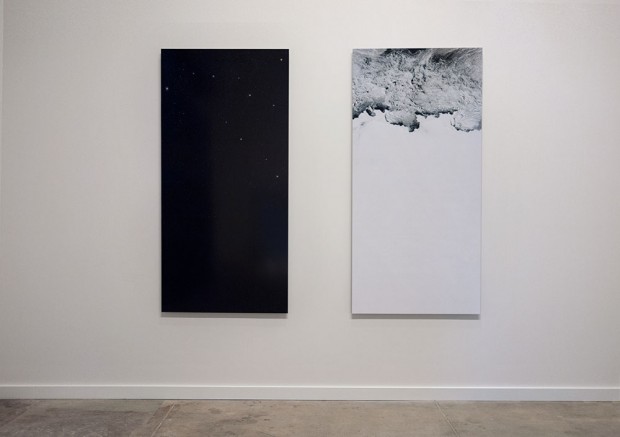
New Work #185. Jordan Tate. 2014. Pigment prints. 26 x 74 inches each. Left image printed on Canson High Gloss. Right image printed on Hahnemeuhle Ultra Smooth Rag. Courtesy image.
According to the catalog SUPERBLACK began over a drink in October, 2012 as Fred Bidwell and his wife Laura spoke with Jordan Tate at a party about their plans to open the Transformer Station in Cleveland. The simple question, “Could Jordan create a virtual ‘Black Hole’ … ?” led down a path to SUPERBLACK. The opening text ponders the almost 200 year history of photography and what will become of it as everyone has easy access to image production and distribution. Instagram happens and photography will continue. The pie gets bigger.
Bidwell,referencing two sculptures by Augustus Saint-Gaudene and made by Bela Lyon Pratt, outside the Boston Public Library, Art and Science, writes,”When I think of Jordan Tate’s SUPERBLACK, I imagine Art striding across the steps to grab that orb from Science and make it her own.”
SUPERBLACK is a blackbody, an idealized physical body that absorbs nearly all electromagnetic radiation (visible light, infrared light, ultraviolet light, etc.) regardless of frequency or angle of incidence. It is structurally designed to maximize absorption and incorporates the darkest material that we are currently capable of reproducing – arrays of multi-walled, vertically aligned carbon nanotubes.
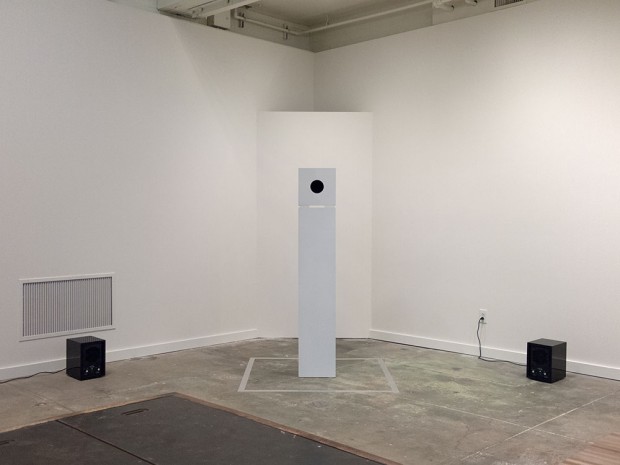
SUPERBLACK: New work by Jordan Tate. Crane Gallery, Transformer Station. 2014. Installation shot. Courtesy image.

SUPERBLACK: New work by Jordan Tate. Crane Gallery, Transformer Station. 2014. Installation shot (detail). Courtesy image.
By displaying an object close to the void it brings the conversation of the sublime back to reality from the illusion of the interior mind. Peering into the void and observing the nearly uncountable nanotubes we can meditate on the physical and real phenomenon of our consciousness made of the same life giving material, carbon, which presents the bottomless blackness before us. The idea of entering the mind to escape reality sought by pure abstraction remains an illusion since neuroscience tells us the mind is the brain and the brain is real matter.
SUPERBLACK gives a nice peek into the limits. As science pushes forward, it reaches small breaks and plateaus allowing for contemplation. While art may help us ponder the void and the void in SUPERBLACK is the deepest and darkest you will most likely ever see, Science already has the basketball again, twirling it on its finger. It pushes forward to find and probe the void.
According to NASA the material will allow for more sensitive collection of light from the deep reaches of the universe by minimizing light contamination in sensitive instruments. In a way photography, if defined as the collection of light, is still the probing tool of choice for science and art. Both play the same game on the same court of reality. The score may be lopsided, the team in green and yellow may not be able to compete with the red white and blue team’s ball dribbling antics but the ongoing match entertains and delights.
Time for some fruit cake.
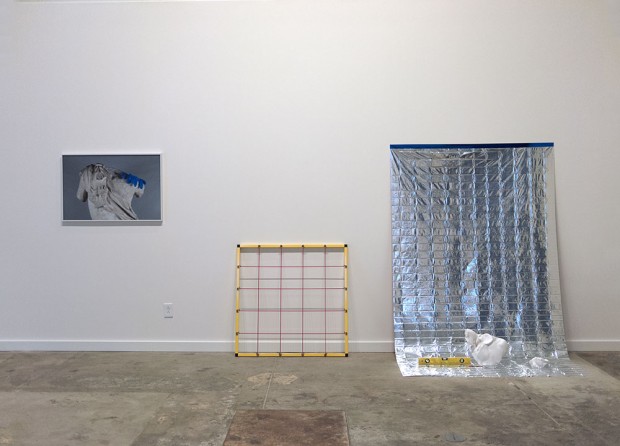
New Work #179. Jordan Tate. 2014. 120 x 80 x 24 inches. Mylar Emergency Blanket, Cast Plaster, Level, Mylar Tape, Provenience Drawing Square. Courtesy image.
April 8, 2014 by Jimmy Kuehnle

Ray of Light. Christian Patterson.2007. Archival pigment print 40 x 60 inches. Collection of Fred and Laura Ruth Bidwell. Photo courtesy of artist.
Science wins. Check and mate.
Now on to tasty fruit cake.
It still costs 98 cents, for a whole cake or just a piece? It must come with pink icing and a red cherry. Tires still have gleaming wide white walls. A murder’s hair comes pre-sculpted like James Dean’s and hood ornaments project out longer than a foot.
Looking at the images from Redheaded Peckerwood by Christian Patterson, we fall into another time, a surreal time. Except for some archival images and artifacts all are contemporary to within the last nine years, though the presence of a different time inhabits the images. Even the unrelated house fire seems like a still from a movie featuring John Wayne fighting oil well fires. Questions arise. Who wore or wears the white fur coat? Who spilled anti freeze in the snowy tire tracks. Did the murder or murderers see this yellow-flowered wallpaper? Whose soda bottle is that? What happens after the shot is fired? Violence, pain, tragedy, loss of innocence happens.
Christian said that his interest in photography grew after moving to New York in the late 1990’s. Later he traveled to Memphis and for three years worked as William Eggleston’s full time assistant and archivist. He said that as a child of the 1970’s he felt a familiarity and nostalgia with Eggleston’s work and in Memphis he incubated and matured as an artist. He became more self-aware and self-critical and filled with a desire to make work truly his own.

Fruit Cake. Christian Patterson. 2011. Oil on paper board. 20 x 16 inches. Collection of the artist. Photo courtesy of artist.
Later, he saw the film, Badlands, based on a true story of Charles Starkweather, a 19-year-old from Lincoln, Nebraska, with his 14-year-old girlfriend, Caril-Ann Fugate, murdering 11 people during America’s simultaneous experience of the emergence of the teenager, the cold war and the space race. The real story, so much more horrible than the romantic depiction in the movie, provided the artist a road map to travel and take photographs along the way. The exhibition at the Transformer Station traces the artist’s five-year annual trek to the site of Nebraska’s most infamous murder story.
In the winter of January 2005 with average temperatures around 22 degrees, he first traced the path 500 miles west and then 500 miles east. He repeated this pilgrimage five times over five years, at the same time of year the murders took place, working for seven to ten days each visit. He worked as a detective in reverse as well as a photographer and looked for traces of the past still in the present.
Research included visits to the archives of newspapers that originally covered the story, police archives, museums and sites of the crimes. He combed through piles of old documents covered with the patina of time. Does the artist serve multiple roles as curator, detective, photographer, archivist? Inspecting victim’s wallets filled with everything from the mundane to bitter-sweet, brutal crime scene photographs and the real murder weapons chillingly reminded Patterson this was not a movie.

Prairie Grass Leak. Christian Patterson. 2009. Archival pigment print. 40 x 50 inches. Collection of Fred and Laura Ruth Bidwell. Photo courtesy of artist.
Glancing around the room we begin our own journey of discovery. The images of different sites and subject matter begin to give a full picture of a time and place inhabited by real people. Sunlight frames a door to a shop. Pink stripes in slushy snow evoke blood as does a kept photographic accident that allowed light to spill into the large format camera creating a pink haze over a field of tall grass. Did the police chase the suspects through this field? Museum board with shotgun blasts remind us that we too would tear apart from the all too real gun violence. The whole situation is “bad news.”
Similar to how our eyes constantly dart around the real environment, in the gallery we construct a virtual image in our brain from many small slices rather than taking in one big organic megapixel image. Jumping from an old gas station to a soda bottle, to a burnt out neon hotel sign, to fire, to shotgun blasts, a tire, a field of futile flight, a dingy stuffed blue poodle facing the wall, a smiling happy couple, we create our own virtual world in our heads, somehow more complete than an accurate play by play of events.
The contemporariness of the photographs makes them even more full and real. Everything once had a place and meaning in the world but now stripped of location and context the viewer must provide meaning. In his artist talk at the Transformer Station, about the visual presentation of the research and story, he said it is an “attempt to reconstruct, deconstruct, and ultimatly fragment it and ultimately turn it inside out.” He produced accurate handmade copies of documents found in the archives and included them in the middle pages of the book.
The images have a forensic feel. By including photographs with evidence of the artist’s presence, such as a dirty bed slept in after a late night at the bar while on location, the filth seems to coat the artist as he gets too close to horror and can not avoid contamination. Tragedy permeates the story and them more we look, it saturates us. Patterson inserts himself, referencing news art by outlining in gray a bottle of Oregon Trail soda set on a diner counter, the actual bottle found rolling around in the trunk of getaway car, borrowed for a few hours from a museum.
Since only two people know what really happened and one of them is dead, the artist lets go of truth and documentation and tells a compelling visual story. The artist leaves decisions to us. Complexity, evidence and mystery lies waiting for our journey to explore, to dive in.

Oregon Trail Bottle. Christian Patterson. 2007. Hand-painted silver gelatin print. 8 x 10 inches. Collection of Fred and Laura Ruth Bidwell. Photo courtesy of artist.
What’s the score? Right, Science up but Art remains in the game, like the Harlem Globetrotters toying with their “stooge” opponent, the Washington Generals.
In the catalog interview with Lisa Kurzner, Jordan Tate discusses the need for “single point objective perception” for communication. He tells the story of Descartes observation of how a stick appears bent in the water. Jordan says that assumes “we actually believed the stick was bent” and that a world where sticks really bend in water would be no different than a world wear they only appear bent “when it is accepted as reality.” We live in such a world. Each time we look at a sunrise we see the bent stick and accept it as reality. The earth’s atmosphere acts as a lens, bending the light of the sun up so the sun appears two minutes before it actually “rises”. Unlike the bent stick, we all believe we directly observe the sun yet we observe something eight minutes in the past and in the case of a sunrise something that will not “really” happen for another two minutes.
Science may trump Art in providing a “single point objective perception” for communication but Art charges up, amplifies, energizes and contextualizes our human experience of those communications of reality.

New Work #185. Jordan Tate. 2014. Pigment prints. 26 x 74 inches each. Left image printed on Canson High Gloss. Right image printed on Hahnemeuhle Ultra Smooth Rag. Courtesy image.
According to the catalog SUPERBLACK began over a drink in October, 2012 as Fred Bidwell and his wife Laura spoke with Jordan Tate at a party about their plans to open the Transformer Station in Cleveland. The simple question, “Could Jordan create a virtual ‘Black Hole’ … ?” led down a path to SUPERBLACK. The opening text ponders the almost 200 year history of photography and what will become of it as everyone has easy access to image production and distribution. Instagram happens and photography will continue. The pie gets bigger.
Bidwell,referencing two sculptures by Augustus Saint-Gaudene and made by Bela Lyon Pratt, outside the Boston Public Library, Art and Science, writes,”When I think of Jordan Tate’s SUPERBLACK, I imagine Art striding across the steps to grab that orb from Science and make it her own.”
SUPERBLACK is a blackbody, an idealized physical body that absorbs nearly all electromagnetic radiation (visible light, infrared light, ultraviolet light, etc.) regardless of frequency or angle of incidence. It is structurally designed to maximize absorption and incorporates the darkest material that we are currently capable of reproducing – arrays of multi-walled, vertically aligned carbon nanotubes.

SUPERBLACK: New work by Jordan Tate. Crane Gallery, Transformer Station. 2014. Installation shot. Courtesy image.

SUPERBLACK: New work by Jordan Tate. Crane Gallery, Transformer Station. 2014. Installation shot (detail). Courtesy image.
By displaying an object close to the void it brings the conversation of the sublime back to reality from the illusion of the interior mind. Peering into the void and observing the nearly uncountable nanotubes we can meditate on the physical and real phenomenon of our consciousness made of the same life giving material, carbon, which presents the bottomless blackness before us. The idea of entering the mind to escape reality sought by pure abstraction remains an illusion since neuroscience tells us the mind is the brain and the brain is real matter.
SUPERBLACK gives a nice peek into the limits. As science pushes forward, it reaches small breaks and plateaus allowing for contemplation. While art may help us ponder the void and the void in SUPERBLACK is the deepest and darkest you will most likely ever see, Science already has the basketball again, twirling it on its finger. It pushes forward to find and probe the void.
According to NASA the material will allow for more sensitive collection of light from the deep reaches of the universe by minimizing light contamination in sensitive instruments. In a way photography, if defined as the collection of light, is still the probing tool of choice for science and art. Both play the same game on the same court of reality. The score may be lopsided, the team in green and yellow may not be able to compete with the red white and blue team’s ball dribbling antics but the ongoing match entertains and delights.
Time for some fruit cake.

New Work #179. Jordan Tate. 2014. 120 x 80 x 24 inches. Mylar Emergency Blanket, Cast Plaster, Level, Mylar Tape, Provenience Drawing Square. Courtesy image.


